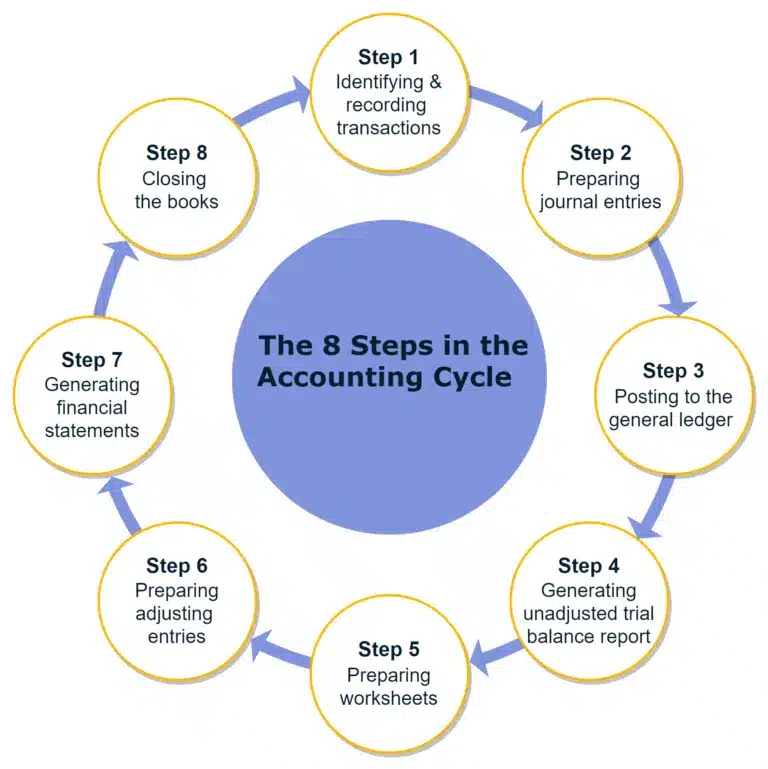What is the Accounting Cycle?
The accounting cycle is a standard, 8-step process that tracks, records, and analyzes all financial activity and transactions within a business. It starts when a transaction is made and ends when a financial statement is issued and the books are closed.
How Does the Accounting Cycle Work?
An accounts receivable or accounts payable team member, full-cycle bookkeeper, or accountant records financial transactions, closes the books for the accounting period, and prepares financial statements, keeping rules of internal control and roles in mind to achieve separation of duties.
Accounting Cycle Steps

8 accounting cycle steps include:
1. Identifying and recording transactions
2. Preparing journal entries
3. Posting to the general ledger
4. Generating unadjusted trial balance report
5. Preparing worksheets
6. Preparing adjusting entries
7. Generating financial statements
8. Closing the books
We examine the accounting cycle steps in more detail.
-
Identifying and recording transactions.
The first step in the accounting cycle is to identify and record transactions through subsidiary ledgers (journals). When financial activities or business events occur, transactions are recorded in the books and included in the financial statements. Types of accounting periods for recording transactions include monthly and annually.
When accounting issues customer invoices, these invoices are issued in numerical sequences for internal control. If a company still issues paper checks, they’re controlled and recorded in sequential numerical series. Any erroneous checks are voided and retained to control the numerical sequence.
As an accounting period example, businesses use a calendar year with an accounting period start date of January 1 and an accounting period end of December 31. Or they may elect with the IRS to use a different month end as a fiscal year for the end of the annual accounting period, also known as the fiscal accounting period. Financial statements may present summarized quarterly and year-to-date information.
Record accounting transactions in the accounting system using double-entry bookkeeping with balancing debits and credits. Generate subsidiary journals and a general journal. Types of subsidiary journals include aged accounts receivable, aged accounts payable, cash disbursements, and fixed assets & accumulated depreciation.
-
Preparing journal entries
To record non-routine accounting transactions, prepare journal entries for a required transaction not recorded through a subsidiary ledger like accounts receivable. You can also use journal entries to make corrections. Use automatic journal entries when possible.
Businesses use accrual accounting rather than cash accounting to follow generally accepted accounting principles (GAAP). The matching principle matches revenue with related expenses by recognizing and assigning them to the proper accounting period in GAAP accounting. Journal entries record accruals and reverse them in the next accounting period when that month’s accruals are determined.
Your accounting system will let you set up automatic recurring transactions for subscription billing like SaaS software. You’ll be able to automatically set up a journal entry for a monthly transaction like prepaid insurance expense that needs to be recognized as insurance expense instead of a prepaid asset as time elapses.
Depreciation should automatically be generated as a journal entry when you correctly set up the fixed asset in the accounting software or ERP system.For non-routine transactions like M&A transactions, you’ll need to analyze the transaction using worksheets and prepare and record journal entries for the deal.
-
Posting to the general ledger
Your accounting system will let you post subsidiary journals and journal entries to the general ledger.
-
Generating unadjusted trial balance report
When you generate an unadjusted trial balance report from the financial records, you’re checking for errors to ensure that all transactions are recorded in the general ledger. The trial balance format is that every general ledger account balance or total is listed without the details. With a double-entry bookkeeping system, total debits should equal total credits.
The unadjusted trial balance report is created by your accounting software. Use the report to make sure that total debits and total credit balance and analyze it for later making adjusting entries as corrections.
-
Preparing worksheets
Use worksheets to analyze, reconcile, and identify adjusting entries and consolidation entries. When possible, use the capabilities provided by your accounting system.
Each balance sheet account should be reconciled at least monthly to find and correct errors with adjusting journal entries. Compare each of the bank accounting statements to its general ledger cash account. A list of cash reconciling items will include outstanding payments and outstanding deposits that haven’t yet cleared the bank and bank service fees.
For other balance sheet items, reconcile the accounts receivable and accounts payable aging journals to the general ledger. Reconcile more assets and liabilities, including inventory, fixed assets, prepaid assets, accrued liabilities, retained earnings, and owner’s equity to the general ledger.
To reconcile inventory balances, businesses take cycle counts, which are sample inventory counts during the year. Companies take a comprehensive physical inventory to compare count quantities with perpetual inventory balances in a month with lower business activity. In the physical inventory reconciliation process, cost accounting makes necessary and approved adjustments to the detailed financial records and journal entries.
Note that companies can perform some accounting process reconciliations like payments reconciliation automatically with AP automation software.
In the consolidation process for multi-entity companies, income statements and balance sheets need to be combined. But intercompany profit needs to be eliminated as a worksheet adjustment because these transactions are not third-party transactions with outsiders. Otherwise, the profit would be too high.
-
Preparing adjusting entries
Make adjusting journal entries to correct errors and reflect any differences noted in reconciling balance sheet accounts. Journal entries require review and approval.
After entering adjusting entries and posting them to the general ledger, total debit balances should equal total credit balances as an accounting control process. You can check by running and reviewing an adjusted trial balance report.
-
Generating financial statements
Choose your customized financial reports to generate financial statements for the accounting period, whether monthly or year-end. Your financial statements can be set up to show quarterly totals in many accounting systems. The SEC requires quarterly financial reporting for public companies. Financial statements have a management review and approval process before they are issued.
Types of financial statements of a company include:
• Balance sheet
• Statement of owner’s equity
• Income statement
• Statement of cash flowsThe accounting equation for the balance sheet is assets minus liabilities equals owner’s equity.
-
Closing the books
Perform step 8 only at fiscal or calendar year-end, but not for a normal month-end close.
Close income statement temporary accounts into a permanent account. Temporary accounts include the revenue and expense accounts. At year-end, net income or loss is closed into the permanent account, retained earnings. Revenue and expense ledger account balances are reduced to zero through a closing entry in the system.
Prepare a post-closing trial balance report at the end of the accounting period for the year. Again, ensure that total debits equal total credits. The temporary ledger accounts should be zeroed out if you’ve completed the year-end accounting close process correctly. Verify the beginning balance of retained earnings that will be used starting with the next monthly accounting period close in the following business year.
When the post-closing trial balance is good, you’ve reached the completion of the accounting cycle at year-end.
Although you’ve technically reached the last step of the accounting cycle for year-end you may still need to enter adjusting entries from the CPA firm’s financial audit into the accounting system for the year. You can open a new accounting period to begin recording transactions for the accounting cycle of the next month and year.
Transform Your Accounting Cycle
You need a dynamic, end-to-end payables solution that automates the basic accounting process, so your team can focus on growth.
Accounting Cycle vs Operating Cycle
The accounting cycle vs operating cycle are entirely different financial terms. The accounting cycle consists of the steps from recording business transactions to generating financial statements for an accounting period. The operating cycle is a measure of time between purchasing inventory, selling the inventory as a product, and collecting cash from the sales transaction.
The operating cycle can be expressed in a formula as the sum of the financial analysis ratios for days’ sales outstanding and the average collection period. Understanding the operating cycle in your business is essential for cash flow management.
Why is the Accounting Cycle Important?
The accounting cycle is used by businesses and organizations to record transactions and prepare financial statements. The standardized accounting cycle process (supported by accounting systems) is important because it helps business owners, small businesses, and established companies close their books for the accounting period. It also helps to generate financial information to perform financial statement analysis and manage the business.
The accounting department uses a customized and detailed accounting close checklist that reflects items to be completed during each accounting cycle; with responsibilities and deadlines assigned, and documentation of completion times and approvals for each task. Use of a checklist with deadlines in the accounting cycle improves accountability and process management.
CPA firms can review or audit the financial statements and drill down to the underlying financial transactions and accounting records to test account balances.
Stakeholders, including management, the Board of Directors, lenders, shareholders, and creditors, can analyze the financial statement results for the accounting cycle period.
Optimizing the Accounting Cycle
One way in which companies are investing wisely is with accounting automation software. More and more CFOs are using end-to-end automated solutions to scale and overcome additional complexities, as they enter new markets and add new entities. Start your research with our eBook: The Future Office of Finance.

